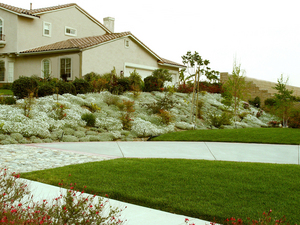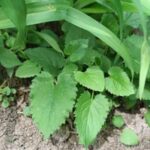Groundcovers are a lovely way to help prevent erosion, and often cover a less than desirable view. Groundcover plants come in all shapes and sizes, including those that flower, and in a variety of growing requirements. For full sun, whether on a bank or just to fill a planting area, try some of these plants to work for you. Many plants are also drought tolerant, but require regular watering until they get their roots well established.
Low Growing Ground Cover
These are the little fellows, fairly ground hugging, up to 6″ high, as most groundcovers are thought of. Creeping Sedum falls into this group. The Sedum family is vast, and offers leaf colors in green and tinted with burgundy or pink, plus flowers in a wide range. They also may be clump-forming or aggressive spreaders, so there’s one for most every need. Sedum are succulent and drought-tolerant.
Ice Plant (Delosperma cooperi) grows so well in sun, and tolerant of poor soil and conditions, that it is considered invasive in California. For the rest of us, it’s just an attractive, short groundcover. Ice Plant is another succulent that stores water. It’s fat leaves are covered in a mildly reflective layer, which helps it to deflect sunlight and at the same time gives it a frosty look. They have purple-pink blooms in the summer, and there are Delosperma varieties that bloom white, yellow, coppery, and other colors, which are sometimes a little less hardy that the D. cooperi, but lovely none the less.
Another evergreen is moss phlox (phlox subulata) or creeping phlox (p. stolonifera). These two are actually different plants, but look similar and act the same. These plants have short stems and leaves that look almost like spiky grass, and they grow along the ground. They flower in the spring in shades of lavender, pink and white. They prefer some shade, so if your sunny spot gets any relief, like in the afternoon, it helps them along.
For walkways where a fragrant surprise is welcome, Creeping Thyme is a good choice. Tiny leaves on short stems make a living carpet that is tolerant of most conditions. The recent popularity of Creeping Thyme has generated new leaf colors and tints to suit gardeners and landscapers alike. Of course, the old standby Liriope, or lily turf, and the similar Opthiogon, are widely available and have green, blackish, or variegated types to choose from.
Medium height ground covers
For a slightly higher mass, many Juniper varieties can fill the bill. They are short shrubs that grow horizontally; Junipers planted in groups will neatly fill in around trees or taller plantings. Blue Rug Juniper (Juniper horizontalis) is an old favorite, with it’s bluish tint, as well as the lighter Blue Pacific Juniper (Juniperus conferta). Their long feathery branches lie along the ground at 6-10 inches height.
Mass plantings of daylilies (Hemerocallis) serve well as a grassy looking groundcover that flowers in a choice of over 1000 colors and varieties. They are hardy perennials that come back year after year. In Tennessee, mass planting of Stella d’Oro daylilies are mass planted at rest stops along the highway.
Hostas are valued for their shade tolerance, but grow quite well in sun, also. If you have some afternoon dappled shade, so much the better! Hostas will grow in increasing mounds, so mass plantings should be spaced a foot or more apart. The largest variety of Hosta, ‘Sum and Substance’, has leaves that may be 6″ or more across, and the mound may reach over a foot tall and several feet across, making an impressive display. They prefer soil that is not dry, but will reward you with your choice of leaf colors from gold-green to blue-green, as well as variegated types.
Tall ground covers
A mounding variety of Juniper in gray-blue is Blue Star Juniper (Juniper squamata), with a dense mass of branches covered in short needles, eventually growing to 3′ across and almost as high. Plantings spaced 2-3′ apart will gradually cover everything in mounds of silvery blue.
Artemesia variety ‘Powis Castle’ is a gray-green mounding plant that grows to about 2-3 feet and spreads 3-4 feet. The leaves are finely cut and ferny, and give a light and airy look. Other varieties of Artemesia may be single stems, but spread to fill in areas with their typically airy feel.
The recent popularity of ‘Autumn Joy’ Sedum and it’s many subsequent cultivars has brought this family of plants to the forefront. Once established they are drought tolerant and carefree, and offer such variety it is difficult not to find one in the height and color you seek.
And for a very tall groundcover that can serve as a hedge or barrier, large ornamental grasses are made for you. The form very dense clumps several feet across, and are dense and mostly free of diseases and pest. Unfortunately, they also provide a great harbor for insects, and would not recommend them for use near the home.






